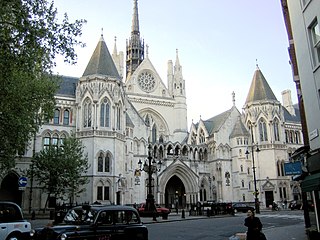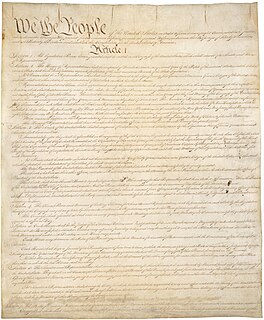Related Research Articles

In law, common law, also known as judicial precedent, judge-made law, or case law, is the body of law created by judges and similar quasi-judicial tribunals by virtue of being stated in written opinions. The defining characteristic of “common law” is that it arises as precedent. In cases where the parties disagree on what the law is, a common law court looks to past precedential decisions of relevant courts, and synthesizes the principles of those past cases as applicable to the current facts. If a similar dispute has been resolved in the past, the court is usually bound to follow the reasoning used in the prior decision. If, however, the court finds that the current dispute is fundamentally distinct from all previous cases, and legislative statutes are either silent or ambiguous on the question, judges have the authority and duty to resolve the issue. The court states an opinion that gives reasons for the decision, and those reasons agglomerate with past decisions as precedent to bind future judges and litigants. Common law, as the body of law made by judges, stands in contrast to and on equal footing with statutes which are adopted through the legislative process, and regulations which are promulgated by the executive branch. Stare decisis, the principle that cases should be decided according to consistent principled rules so that similar facts will yield similar results, lies at the heart of all common law systems.
A class action, also known as a class-action lawsuit, class suit, or representative action, is a type of lawsuit where one of the parties is a group of people who are represented collectively by a member or members of that group. The class action originated in the United States and is still predominantly a US phenomenon, but Canada, as well as several European countries with civil law, have made changes in recent years to allow consumer organizations to bring claims on behalf of consumers.
A tort is a civil wrong that causes a claimant to suffer loss or harm, resulting in legal liability for the person who commits the tortious act. In some, but not all, civil and mixed law jurisdictions, the term delict is used to refer to this category of civil wrong, though it can also refer to criminal offences in some jurisdictions and tort is the general term used in comparative law. The word tort stems from Old French via the Norman Conquest and Latin via the Roman Empire. The word 'tort' was first used in a legal context in the 1580s, although different words were used for similar concepts prior to this time.
Equity is a particular body of law that was developed in the English Court of Chancery. Its general purpose is to provide a remedy for situations where the law is not flexible enough for the usual court system to deliver a fair resolution to a case. The concept of equity is deeply intertwined with its historical origins in the common law system used in England. However, equity is in some ways a separate system from common law: it has its own established rules and principles, and was historically administered by separate courts, called "courts of equity" or "courts of chancery".

English law, also known as English and Welsh law or English Common law, is the common law legal system of England and Wales, comprising mainly criminal law and civil law, each branch having its own courts and procedures.
A lawsuit is a proceeding by a party or parties against another in the civil court of law. The archaic term "suit in law" is found in only a small number of laws still in effect today. The term "lawsuit" is used in reference to a civil action brought by a plaintiff demands a legal or equitable remedy from a court. The defendant is required to respond to the plaintiff's complaint. If the plaintiff is successful, judgment is in the plaintiff's favor, and a variety of court orders may be issued to enforce a right, award damages, or impose a temporary or permanent injunction to prevent an act or compel an act. A declaratory judgment may be issued to prevent future legal disputes.
The forms of action were the different procedures by which a legal claim could be made during much of the history of the English common law. Depending on the court, a plaintiff would purchase a writ in Chancery which would set in motion a series of events eventually leading to a trial in one of the medieval common law courts. Each writ entailed a different set of procedures and remedies which together amounted to the "form of action".
Nuisance is a common law tort. It means that which causes offence, annoyance, trouble or injury. A nuisance can be either public or private. A public nuisance was defined by English scholar Sir James Fitzjames Stephen as,
"an act not warranted by law, or an omission to discharge a legal duty, which act or omission obstructs or causes inconvenience or damage to the public in the exercise of rights common to all Her Majesty's subjects".
The Federal Rules of Civil Procedure govern civil procedure in United States district courts. The FRCP are promulgated by the United States Supreme Court pursuant to the Rules Enabling Act, and then the United States Congress has seven months to veto the rules promulgated or they become part of the FRCP. The Court's modifications to the rules are usually based upon recommendations from the Judicial Conference of the United States, the federal judiciary's internal policy-making body.

Jack Bertrand Weinstein was a United States district judge of the United States District Court for the Eastern District of New York. Until his entry into inactive senior status on February 10, 2020, he maintained a full docket of cases.
Conflict of laws in the United States is the field of procedural law dealing with choice of law rules when a legal action implicates the substantive laws of more than one jurisdiction and a court must determine which law is most appropriate to resolve the action. In the United States, the rules governing these matters have diverged from the traditional rules applied internationally. The outcome of this process may require a court in one jurisdiction to apply the law of a different jurisdiction.

Tort reform refers to changes in the civil justice system in common law countries that aim to reduce the ability of plaintiffs to bring tort litigation or to reduce damages they can receive. Such changes are generally justified under the grounds that litigation is an inefficient means to compensate plaintiffs; that tort law permits frivolous or otherwise undesirable litigation to crowd the court system; or that the fear of litigation can serve to curtail innovation, raise the cost of consumer goods or insurance premiums for suppliers of services, and increase legal costs for businesses. Tort reform has primarily been prominent in common law jurisdictions, where criticism of judge-made rules regarding tort actions manifests in calls for statutory reform by the legislature.
Feres v. United States, 340 U.S. 135 (1950), combined three pending federal cases for a hearing in certiorari in which the Supreme Court of the United States held that the United States is not liable under the Federal Tort Claims Act for injuries to members of the armed forces sustained while on active duty and not on furlough and resulting from the negligence of others in the armed forces. The opinion is an extension of the English common-law concept of sovereign immunity.
Theodore H. Frank is an American lawyer, activist, and legal writer, based in Washington, D.C. He is the counsel of record and petitioner in Frank v. Gaos, the first Supreme Court case to deal with the issue of cy pres in class action settlements; he is one of the few Supreme Court attorneys ever to argue his own case. He wrote the vetting report of vice-presidential candidate Sarah Palin for the John McCain campaign in the 2008 presidential election. He founded the Center for Class Action Fairness (CCAF) in 2009; it temporarily merged with the Competitive Enterprise Institute in 2015, but as of 2019 CCAF is now part of the new Hamilton Lincoln Law Institute, a free-market nonprofit public-interest law firm founded by Frank and his CCAF colleague Melissa Holyoak. The New York Times calls him the "leading critic of abusive class-action settlements"; the Wall Street Journal has referred to him as "a leading tort-reform advocate" and praised his work exposing dubious practices by plaintiffs' attorneys in class actions.
Civil procedure in the United States consists of rules that govern civil actions in the federal, state, and territorial court systems, and is distinct from the rules that govern criminal actions. Like much of American law, civil procedure is not reserved to the federal government in its Constitution. As a result, each state is free to operate its own system of civil procedure independent of her sister states and the federal court system.

Edelson PC is an American plaintiffs' law firm that focuses on public client investigations, class actions, mass tort, and consumer protection laws. Edelson’s cases include class action settlements against Facebook for $650 million (2021), social casino apps for nearly $200 million (2021), and a $925 million verdict against ViSalus (2020.)

The law of the United States comprises many levels of codified and uncodified forms of law, of which the most important is the nation's Constitution, which prescribes the foundation of the federal government of the United States, as well as various civil liberties. The Constitution sets out the boundaries of federal law, which consists of Acts of Congress, treaties ratified by the Senate, regulations promulgated by the executive branch, and case law originating from the federal judiciary. The United States Code is the official compilation and codification of general and permanent federal statutory law.
A private attorney general is an informal term originating in common law jurisdictions for a private attorney who brings a lawsuit claiming it to be in the public interest, i.e., benefiting the general public and not just the plaintiff, on behalf of a citizen or group of citizens. The attorney may, at the equitable discretion of the court, be entitled to recover attorney's fees if they prevail. The rationale behind this principle is to provide extra incentive to private attorneys to pursue suits that may be of benefit to society at large. Private attorney general suits are commonly, though not always, brought as class actions in jurisdictions that permit the certification of class action lawsuits.
Bristol-Myers Squibb Co. v. Superior Court of California, San Francisco County, 582 U.S. ___ (2017), was a United States Supreme Court case in which the Court held that California courts lacked personal jurisdiction over the defendant on claims brought by plaintiffs who are not California residents and did not suffer their alleged injury in California. It is part of a group of six cases decided since 2011 that have greatly changed the application of personal jurisdiction. It was praised by legal scholars for properly applying the Fourteenth Amendment's Due Process Clause.
Pierson v. Ray, 386 U.S. 547 (1967), was a United States Supreme Court case in which the Court first introduced the justification for qualified immunity for police officers from being sued for civil rights violations under Section 1983, by arguing that "[a] policeman's lot is not so unhappy that he must choose between being charged with dereliction of duty if he does not arrest when he had probable cause, and being mulcted in damages if he does."
References
- ↑ FindLaw, Litigation Issues: What is a Class Action?
- ↑ Markt & Co Ltd. v Knight Steamship [1910] 2 K.B. 1021 at 1034 per Fletcher-Moulton LJ (Note however that in this case, which has determined the place of the representative action in English law ever since, that it is possible that the Bill of Peace and representative action were substantially confused in the minds of all the judges.)
- ↑ A DISTANT MIRROR: THE BILL OF PEACE IN EARLY AMERICAN MASS TORTS AND ITS IMPLICATIONS FOR MODERN CLASS ACTIONS, Thomas D. Rowe, Jr.
- ↑ LEVELING THE PLAYING FIELD IN THE GARDEN STATE: A GUIDE TO NEW JERSEY CLASS ACTION CASE LAW [ permanent dead link ], page 5
- ↑ "American Bar Association, Looking Back . . . In a Collective Way, A short history of class action law, By Susan T. Spence". Archived from the original on 2005-02-16. Retrieved 2009-12-06.